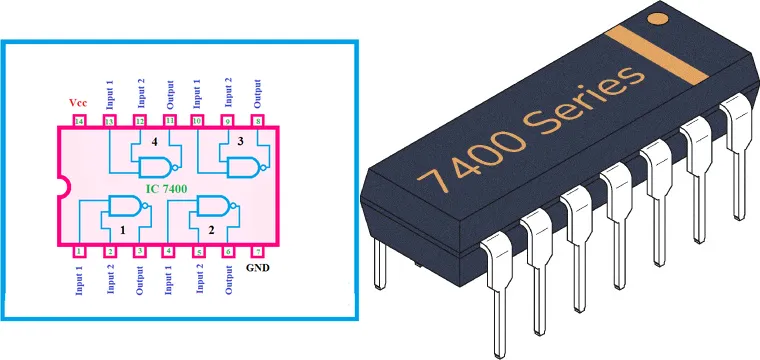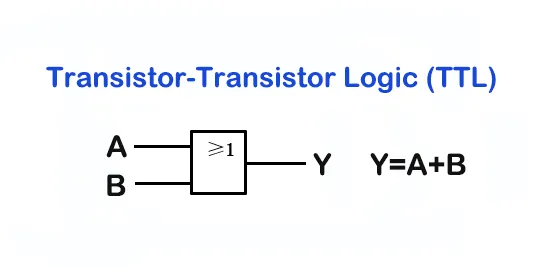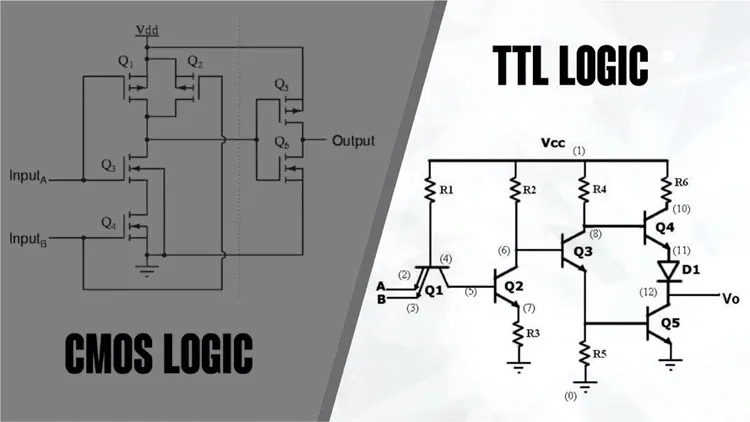TTL, or Transistor-Transistor Logic, is a class of digital circuits built using bipolar junction transistors (BJTs) and resistors. The TTL logic chip was first introduced in the 1960s by Texas Instruments and has since played a significant role in the development of digital electronics.
TTL logic chips are widely used in applications requiring a high speed of operation and moderate power consumption. This article delves into the details of what TTL logic chips are, how they work, their advantages and disadvantages, and their applications in modern technology.
Definition and History of TTL Logic Chip

TTL logic is a type of digital circuit in which both the logic gating (AND, OR, NOT, etc.) and the amplification are performed by transistors. The term “transistor-transistor logic” derives from the use of two bipolar junction transistors for switching purposes.
TTL was invented in 1961 by James L. Buie at TRW and became commercially available from Texas Instruments in 1964. TTL logic quickly gained popularity due to its speed, reliability, and ease of use in various electronic applications.
How TTL Logic Chips Work

TTL logic chips operate based on the use of transistors as switches. In a typical TTL circuit, the basic building block is the NAND gate. A NAND gate has multiple inputs and a single output. The output is low (0) only when all inputs are high (1); otherwise, the output is high (1).
Key Components of a TTL Circuit:
- Bipolar Junction Transistors (BJTs): These act as the switching elements in the circuit. They can rapidly switch between their on (saturation) and off (cutoff) states, providing the necessary logic operations.
- Resistors: These are used to limit the current and establish the correct voltage levels for the transistors to operate.
- Diodes: In some TTL families, diodes are used to improve switching speed and performance.
Operation of a Basic TTL NAND Gate
A standard TTL NAND gate typically includes a multi-emitter transistor, a phase-splitting transistor, and a totem-pole output stage. Here’s a simplified explanation of how a basic TTL NAND gate operates:
- Input Stage (Multi-Emitter Transistor): The input stage consists of a transistor with multiple emitters, each connected to an input. If any input is low, the transistor is turned off, resulting in a high output. If all inputs are high, the transistor is turned on, leading to a low output.
- Phase Splitter: This stage inverts the signal and provides two out-of-phase signals to the output stage.
- Totem-Pole Output Stage: This stage includes two transistors arranged in a totem-pole configuration to provide low output impedance, ensuring the gate can drive multiple inputs and maintain signal integrity.
Types of TTL Logic Families
Over the years, several variations of TTL logic families have been developed to enhance performance characteristics such as speed, power consumption, and noise immunity. Some of the common TTL families include:
- Standard TTL: The original TTL family, is characterized by moderate speed and power consumption.
- Low-Power TTL (L): Designed to consume less power, suitable for battery-operated devices.
- High-Speed TTL (H): Offers faster-switching speeds at the cost of higher power consumption.
- Schottky TTL (S): Incorporates Schottky diodes to prevent transistors from saturating, resulting in faster switching speeds.
- Low-Power Schottky TTL (LS): Combines low power consumption with the speed advantages of Schottky diodes.
Advantages of TTL Logic Chips
TTL logic chips have several distinct advantages that have contributed to their widespread adoption in various electronic applications. Let’s delve deeper into these advantages:
| PARAMETERS | 74-Series TTL Sub-families | UNITS | ||||||
| Standard | L | H | S | LS | AS | ALS | ||
| Propagation Delay (2-input NAND gate) Power Dissipation (per gate) | 9nS | 33 | 6 | 3 | 8 | 2 | 4 | nS |
| 10 mW | 1 | 22 | 20 | 2 | 22 | 1 | mW | |
| VIH VOH NM-H | 2.0V | 2.0 | 2.0 | 2.0 | 2.0 | 2.0 | 2.0 | V |
| 2.4V | 2.4 | 2.4 | 2.7 | 2.7 | VDD-2V | VDD-2V | V | |
| 400 mV | 400 | 400 | 700 | 700 | 700 | 700 | mV | |
| VIL VOL NM-L | 0.8V | 0.7 | 0.8 | 0.8 | 0.8 | 0.8 | 0.8 | V |
| 0.4V | 0.3 | 0.4 | 0.5 | 0.5 | 0.5 | 0.5 | V | |
| 400 mV | 300 | 400 | 300 | 300 | 300 | 300 | mV | |
- Speed:
TTL logic chips are known for their fast switching speeds, making them suitable for high-speed digital circuits. The rapid switching capabilities are due to the use of bipolar junction transistors (BJTs), which can switch on and off quickly. This speed is particularly beneficial in applications that require rapid data processing, such as in early computers, microprocessors, and real-time control systems.
The ability to operate at high frequencies without significant delays ensures that TTL logic chips can handle demanding computational tasks efficiently.
- Noise Immunity:
TTL circuits generally have good noise immunity, reducing the risk of false triggering. Noise immunity refers to the circuit’s ability to withstand external electrical noise without malfunctioning. TTL logic levels are well-defined, with distinct voltage thresholds for logical ‘0’ and ‘1’.
This clear separation between high and low states helps prevent noise from causing erroneous switching, making TTL circuits more reliable in noisy environments. This characteristic is particularly important in industrial and automotive applications, where electrical noise can be prevalent.
- Availability:
TTL logic chips are widely available and come in various configurations to suit different applications. Since their introduction in the 1960s, TTL chips have been mass-produced by numerous manufacturers, ensuring a steady supply. This widespread availability makes them a convenient choice for designers and engineers.
Additionally, the variety of TTL logic families, such as standard TTL, low-power TTL, high-speed TTL, and Schottky TTL, allows users to select the most appropriate chip for their specific needs, balancing speed, power consumption, and cost.
- Compatibility:
TTL logic levels are standardized, ensuring compatibility between devices and manufacturers. This standardization means that a TTL logic chip from one manufacturer will work seamlessly with TTL chips from another manufacturer. This interoperability is crucial in complex systems where components from different sources are integrated.
It simplifies the design process, reduces the risk of compatibility issues, and ensures reliable operation across a wide range of applications. Furthermore, the consistent logic levels make it easier to interface TTL logic circuits with other types of digital and analog circuits.
- Robust Design:
TTL logic chips are robust and can operate reliably under a wide range of conditions. They are designed to handle moderate power levels without significant performance degradation. This robustness makes them suitable for use in harsh environments, such as industrial and military applications, where reliability and durability are critical.
The use of BJTs, which are less susceptible to damage from electrostatic discharge (ESD) compared to MOSFETs used in CMOS technology, further enhances the durability of TTL logic chips.
- Ease of Use:
The straightforward design of TTL logic circuits makes them easy to understand and implement. For engineers and designers, this simplicity translates to shorter development times and easier troubleshooting.
The well-defined electrical characteristics and predictable behavior of TTL logic chips simplify the design process, enabling quicker prototyping and testing. Additionally, extensive documentation and a wealth of application notes are available, providing valuable resources for those working with TTL technology.
- Proven Technology:
TTL logic has been around for decades, and its reliability has been proven in countless applications. This long history means that designers can trust TTL chips to perform as expected. The maturity of the technology also means that many design issues have already been addressed, and solutions are well-documented.
For legacy systems, continuing to use TTL logic chips ensures compatibility and reliability, avoiding the need for costly redesigns.
Applications of TTL Logic Chips
TTL logic chips have been instrumental in the development of various electronic systems. Some common applications include:
- Computers: Early computers and microprocessors heavily relied on TTL logic chips for their operation. The Intel 8080 and Zilog Z80 microprocessors, for example, were built using TTL logic.
- Industrial Control Systems: TTL logic is used in programmable logic controllers (PLCs) and other industrial automation equipment to ensure reliable and fast operation.
- Communication Systems: TTL chips are used in digital communication systems for encoding, decoding, and error detection and correction.
- Consumer Electronics: From early video game consoles to digital watches, TTL logic has been used in a wide range of consumer electronic devices.
- Test Equipment: Oscilloscopes, signal generators, and other test and measurement instruments often use TTL logic for their control circuits.
Evolution and Legacy

With the advent of complementary metal-oxide-semiconductor (CMOS) technology, which offers lower power consumption and higher density, the dominance of TTL logic has declined. CMOS logic circuits, with their ability to operate at a wider range of voltages and their lower power requirements, have largely replaced TTL in new designs. However, TTL logic chips are still in use today, particularly in legacy systems and specific applications where their unique advantages are beneficial.
Transition to CMOS
CMOS technology emerged in the 1970s and quickly gained popularity due to its advantages in power efficiency and integration density. CMOS circuits use complementary pairs of p-type and n-type MOSFETs to achieve logic functions with very low static power consumption. This has made CMOS the preferred choice for modern integrated circuits, from microprocessors to memory chips.
TTL in the Modern Era
Despite the rise of CMOS, TTL logic chips continue to be relevant in several contexts:
- Educational Tools: TTL chips are often used in educational settings to teach students about digital logic design and circuit theory.
- Prototyping and Hobby Projects: Due to their simplicity and availability, TTL chips are popular among hobbyists and engineers for building and testing small-scale digital circuits.
- Legacy Systems: Many industrial and military systems still rely on TTL logic due to their proven reliability and long-term support.
Conclusion
The TTL logic chip represents a significant milestone in the history of digital electronics. Its development in the 1960s paved the way for the rapid advancement of computing and electronic systems.
While modern technology has largely transitioned to CMOS logic, TTL remains an important part of the electronics landscape, both in legacy systems and as a foundational tool for learning and prototyping.
Understanding TTL logic chips provides valuable insights into the evolution of digital circuit design and the principles that continue to underpin modern electronics.